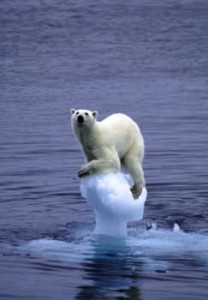By Jason Klein
“Nothing like this has ever happened before.”
– Professor Terry Rapson, from the movie “The Day After Tomorrow”
The study of climate change is by no means an exact science. It is subject to a large number of variables. Forecast models can employ the most sophisticated machines we have ever built, and yet we often discover new and unforeseen data that need to be incorporated into the projections (see IEDRO’s recent article on carbon balance in the Arctic, for example). Unfortunately, circumstances can arise that would make much of our forecasts, debates, technology, preparations, and even blog entries completely irrelevant. The potential for abrupt, cataclysmic shifts in global climate must also be considered in our forecasts for the future.
The end of humanity (or at least the end of the civilization we have grown accustomed to) due to climate change is an extremely difficult prospect to contemplate. Sure, every time we watch a news story about how the hurricane season has had its earliest start in 108 years, or witness wildfires in the western US due to drought, or any of a thousand other climate-related happenings, we think of our negative influence upon our planet’s climate. However disquieting these scenarios may be, the key thing in our minds is that the overall change will be gradual. The disasters are remote, mutable, “down the road.” We believe that we can mediate the global impacts through improving automobile fuel efficiency, installing CFL bulbs, and protesting coal-burning power plants. A climate shift that suddenly turns our world into a desert wasteland, or an ice age that begins virtually overnight, or floods that cover the entire surface with water, are left to the realm of bad science fiction films. Right? Unfortunately, these dramatic shifts are possible . . . and they have happened before.
About 13,000 years ago, something dramatic occurred to initiate a rapid climatic change known as the Younger Dryas Period, which lasted for about 1300 years. No one is sure what led to this shift, but the dominant theory postulates there was a shutdown of the North Atlantic “Conveyor,” which now circulates warm, tropical water northward. This might have been due to a sudden influx of freshwater from melting ice sheets in North America and Greenland causing a disruption in the thermohaline circulation. Other theories about what led to this abrupt climatic change include a volcanic eruption that resulted in a “greenhouse effect;” or an extra-terrestrial impact, as from an asteroid (although this theory has been widely discredited). Whatever the cause, the effects changed the world. The average temperature in the British Isles was 5 °C (41 °F). Drought and desertification spread throughout Asia, perhaps motivating Natufian culture of the Levant to develop agriculture. Meanwhile, in North America, many species of large mammals became extinct, and the Clovis culture of Paleo-Indians disappeared.
Surprisingly, evidence indicates that the climate shift that marked the beginning of the Younger Dryas occurred in less than a decade – virtually overnight in climatic terms. The changes that this period brought about were so dramatic that geologists see this as the end of the Pleistocene epoch, which lasted for over two and a half million years. Some climatic researchers have proposed that humanity’s recent influence upon our planet may be initiating a new epoch in Earth’s evolution – the Anthropocene. We really don’t have any idea what our world will look like for our children and our grandchildren, but we can be sure that it will be very different than the one we live in today. As stated in a recent article in the journal Nature:
Anticipating biological surprises on global as well as local scales, therefore, has become especially crucial to guiding the future of the global ecosystem and human societies. Guidance will require not only scientific work that foretells, and ideally helps to avoid, negative effects of critical transitions, but also society’s willingness to incorporate expectations of biological instability into strategies for maintaining human well-being.
In other words, for everything that our species does we should consider how to deal with the effects of climate change – rapid and gradual, local and global. We cannot afford piecemeal band-aids. The costs of famine, flood and pestilence, is already outweighing the costs of prevention. We have a short window in which we can choose how to mitigate the disasters that loom in our future.
Scientists who study global warming acknowledge that this is only an idea; it must be subject to revision based upon evidence (right now, the overwhelming majority of evidence indicates that human-caused climate change is a real danger). However, the undeniable truth is that these changes might not be as devastating as most people believe . . . they may be much, much worse.
“For years, we operated under the belief that we could continue consuming our planet’s natural resources without consequence. We were wrong.” – -Vice President Raymond Becker, from “The Day After Tomorrow”
References
Anthony D. Barnosky, et al. “Approaching a state shift in Earth’s biosphere.” Nature 486, 52–58 (07 June 2012), retrieved from http://bit.ly/JMeTeB
Fred Guterl. “Climate Armageddon: How the World’s Weather Could Quickly Run Amok.” Scientific American, retrieved from http://bit.ly/JZt3ic


Comments are closed.